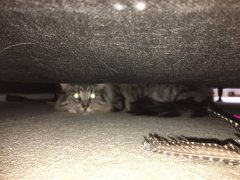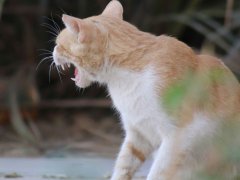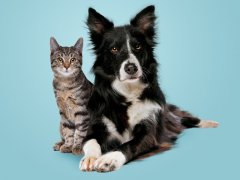
Kirsten McCarthy / Cats.com
Providing suitable food for your cat to eat is one of the fundamentals of feline ownership, and yet it’s not always as simple as it sounds! If your cat won’t eat their dry food, this can be worrying and frustrating in equal measure. There are many reasons why cats won’t eat dry kibble, from individual preference to teeth and gum disease or other illnesses.
Cats might not eat dry food if they’re not used to the taste, smell or texture. Dental disease and other illnesses can also reduce appetite and make eating dry food harder. Make any dietary changes slowly, introduce dry food with some added water and see the vet if your cat won’t eat at all.Key Takeaways
6 Reasons Why Your Cat Won’t Eat Dry Food
Are they just being fussy or is it something more? It can be difficult to tell if your cat is refusing dry kibbles for good reason or not. Understanding some of the reasons why they might elect to leave their food can help us know how to help them.
1. Your Cat Simply Doesn’t Prefer Dry Food
Just like people, cats have strong feelings about what foods they do and do not like. These preferences are often formed in kittenhood. The textures, smells, and flavors of kibble are very different from canned food, which makes this a difficult transition for many cats.
2. They Can Tell Something’s Off
If your cat is suddenly rejecting their dry food, but they’re still happily scoffing the cat treats, check the food packet. Cats might not eat food that’s too old, for fear of stomach upsets, and they might also be sensitive to small changes to the recipe or ingredients.
3. They Have a Problem With the Dish
A cat’s eating habits are usually quite routine, and they can be put out by small changes. Have you altered where you put their food bowl or even changed the dish itself? Cats usually prefer a food dish which is wide and shallow, so that their whiskers don’t constantly rub at the edges of it. They might also prefer a food bowl made from a material that is easily cleaned so it doesn’t retain the aroma of old food or detergent.
4. Your Cat Is Stressed
Cats love to chill, relax, and nap. However, cats can become stressed, sometimes leading to loss of appetite. Loud noises, new pets, territorial squabbles—these can all cause our usually calm cats to feel anxiety. As well as appetite changes, stress in cats can also present as house-soiling, excessive grooming, vocalization, and altered social interactions.
5. They Have Mouth Pain
Dental disease is really common in cats, but the symptoms can be hard to spot. Sore gums, inflammation, tooth resorption, and infections are all very common causes of oral and tooth pain in cats. This can show as cats not wanting to eat their dry food, although they might still eat wet food. You might also notice them drooling more, discolored saliva, eating on one side of the mouth, dropping food from the mouth, or even weight loss.
6. They Have Another Health Issue
Pretty much any form of illness or disease can affect a cat’s appetite. Common culprits include gastrointestinal issues such as constipation, diarrhea, vomiting, or foreign bodies, pancreatitis, liver disease, and kidney disease. If your cat loses their appetite and doesn’t eat for 24 hours, or if they seem unwell in other ways, always seek advice from a vet.
When To Worry

Hiding more and altered interactions with owners can be signs of stress in cats. Kirsten McCarthy / Cats.com
It can be very concerning if your cat won’t eat well for a number of reasons: their nutrition, their hydration, and their general well-being. A cat that isn’t eating is also at risk of developing hepatic lipidosis (fatty liver disease), which can be very serious. However, it can be difficult to know when your cat is just being fussy, and when to step in.
A good general rule is that if your cat hasn’t eaten for 24 hours, seek veterinary attention. You should also be concerned if the lack of appetite is paired with other symptoms such as vomiting, diarrhea, or fever. If your cat’s appetite has gradually dwindled, and they are losing weight, this is also a sign that they might be unwell and should see a vet.
What You Can Do
Changing a cat’s diet can be difficult, but there are ways to make the transition easier. Always seek veterinary attention if your cat is unwell, but here are some home tricks to get cats eating their dry food.
Why Does My Cat Only Eat Wet Food?

Cats develop a good sense of timing around meal schedules and can find a predictable routine comforting. Kirsten McCarthy / Cats.com
Some cats might prefer wet food because it smells stronger and has a more interesting texture that cats love. The extra moisture in wet food is like a hydration boost, which is great since cats sometimes don’t drink enough water. If your cat has dental issues or is missing teeth, wet food is usually easier for them to eat. Cats can be picky eaters, so if yours loves wet food, that’s probably just their favorite.
Keep Transitions Slow
Cats are creatures of habit, and a change in routine can be difficult for them. If you’re changing from wet food to dry and your cat won’t eat the dry food, you might have changed over too quickly. Aim to transition very slowly over a few weeks, and begin by simply adding small amounts of dry food to their usual diet.
Increase the amount slowly every few days. You could also try adding some water to the dry food at first, to ease the transition. If you’re merely changing the type or flavor of dry food, you might still need to change over slowly.
Trial and Error
Cats like protein, and flavors of cat food therefore tend to be meat or fish-based, such as chicken or tuna. Often, cats have a decided taste preference, so try out a few flavors to determine what they like. Always aim for a good quality diet which is complete nutritionally for their age and lifestyle.
Bring Out the Aroma
Cats don’t have huge amounts of taste buds, but they use their excellent sense of smell to search out the most delicious food. Dry food tends to smell less than wet, so increase the appeal by adding some warm water or some meaty stock to attract them.
Low-Stress Routine
If your cat’s eating habits have turned picky, think about their feeding schedule and location. Keep meal times regular and consistent, place bowls in an accessible location and try to reduce any potential stressors for your cat.
Get a Health Check
If your cat isn’t eating well, they might have an underlying health condition. Make note of any other symptoms, and head to your veterinarian for a thorough check. Early detection is often key to successful treatment.
Frequently Asked Questions
Is it okay that my cat only eats wet food?
There are advantages and disadvantages to both wet and dry food. Most cats will do perfectly well on either, as long as the food is nutritionally complete and suitable for your cat’s age and lifestyle.
Why is my cat suddenly picky with food?
Cats don’t respond well to sudden changes in their diet or feeding schedule, so a change in food can lead to fussy eating. Illness and pain—including dental disease—can also affect appetite in cats, so a trip to the vet might be in order.
Is it okay to mix water with dry cat food?
Yes, you can add water or low-sodium broth to dry cat food. This can help encourage some cats to eat it, and can also increase their fluid intake.







